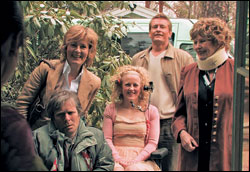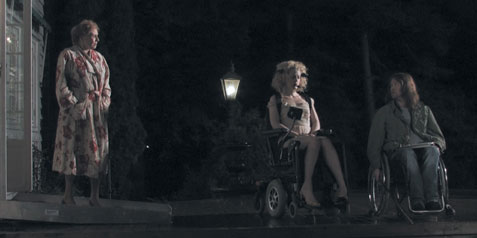The Art of Negative Thinking
Irina Echarry

HAVANA TIMES, Dec. 12 – Before getting to the cinema, I thought we would be among few people showing up at the Riviera Theater to see the film “The Art of Negative Thinking.” I had given my friends a the synopsis of the movie: a wife, agonized by her husband’s bad mood -since he had to rely on a wheelchair to get around- brings home a group of positive thinkers.
By nightfall, her husband manages to get the whole group to think negatively, like him.
Something like that was written on the film festival program, so I didn’t think many people would be interested in seeing how a man extinguishes other people’s joy of living. I was mistaken; there was hardly an empty seat. Are there really that many people in Havana who could get so excited by an issue so seemingly negative?
I didn’t have time to ask myself any other questions; as soon as the Norwegian film directed by Bård Breien began I let myself be swept away by the story.
The group of positivists are themselves in a sad state. It was made up of a man suffering from a cerebral-vascular accident (ruined, cheated on by his wife, rejected by his children, immobile, silent); a young woman who tries to smile the whole time (she’s in a wheelchair with special additions because after her own accident she’s not been able to hold up her head); the girl’s husband (guilty over the accident and having always been a bad lover); and an old woman with a brace on her neck, which makes her who tries hard to appear the most unfortunate in the group.

They are led by a therapist who speaks to them free of paternalism, but who continually indicates what they should do and say.
She’s the one that prohibits them from speaking about negative issues. (That’s why waste baskets exist). They can’t talk about problems or their personal difficulties, only about future plans, good things to come.
In the cinema, many people identified immediately with this small and unhappy group, prevented from speaking about things that really bothered them.
Could it be that we -like them- are a sick society: prisoners within our handicaps, restrained from speaking about them, unable to communicate between ourselves; weary that there always exists someone in charge of saying what is good or bad, what we can or cannot do or say?
Undoubtedly I thought about this as I left the cinema, because while the movie lasted I enjoyed the comedic tone with which its director presented the misfortune of its characters. But whose condition was worse?
It’s an exercise the therapist imposes on them once the main character decides to interact with the group – interacting, while never letting himself fall into the game of the “group leader”. Everyone tries to demonstrate that they feel worse than someone else, as if the physical-emotional state of another person serves to appease or diminish their own unease.
Our own miseries are those that we feel most, those that burden us the most. It doesn’t matter how terrible those of others are.
When the therapist tries to impose her methods on the invalid rebel, confusion begins to reign. With his aggressiveness and irreverence, the main character has achieved what the rest of the group begins to talk about: rebelling, saying what’s forbidden to them.
The therapist doesn’t surrender, as if her work involved treating beings that, due to their physical illnesses, had lost their personalities, their reasoning capacity, thus forcing the rebel to dance to the beat of her favorite music. The response isn’t long in coming: a forceful blow and the therapist falls to the floor. No more psychoanalysis, no more positivism.
All of them are in ecstasy. Someone had done what evidently they had wanted to do from the beginning.
They then begin to be themselves.
Far from sinking into depression, the movie carries us along through the use of laughter and the desire to live, without penetrating the dark paths of melodrama or pity, and without the sweetening that is usually poured on people who have lost some of their abilities (physical or mental) or are born without them.
At the exit of the cinema, the comments flowed in favor of the story. A man -in a wheelchair- displayed a big smile. A group of youth, excited by the irreverent atmosphere of the film, raised their voices recalling one of the main character’s final sentences: Screw yourselves!
And I agreed. Screw those people who want to lock the rest of us in their narrow models of life, ideology and prejudice. Screw all of those who don’t know how to live and because of this make martyrs of everyone around them. Screw the hypocrites, cowards, dictators… and the positivists.






Thanks for telling us about “The Art of Negative Thinking,” Irina. It sounds like a good antidote to all those motivational speakers, addictions therapists and self-help gurus on television up here, whose books take up so much dead space on the shelves our bookstores. Why do folks feel so insecure they must take advice from these “experts?.” The key for unlocking creative energies lies within. Begin by devloping a sense of humor– a dark sense of humor– and feelings for the absurd. It is interesting to watch these “self-help” gurus. Theirs is always a monologue, never a dialogue. They preach before admiring bogs, their audience croaking choruses of approval. Sounds like Bard Breien has a Bunuelian sense of the absurd. You are fortunate in Cuba that cinema is still a social experience, where films can be discussed after their performance. Up here we have bacome oh-so-alienated, watching our DVD’s at home, since most of the “art houses” closed in the…